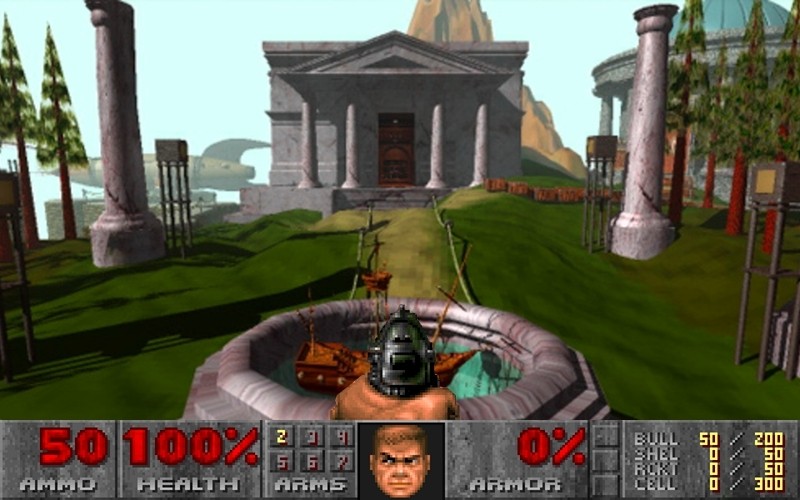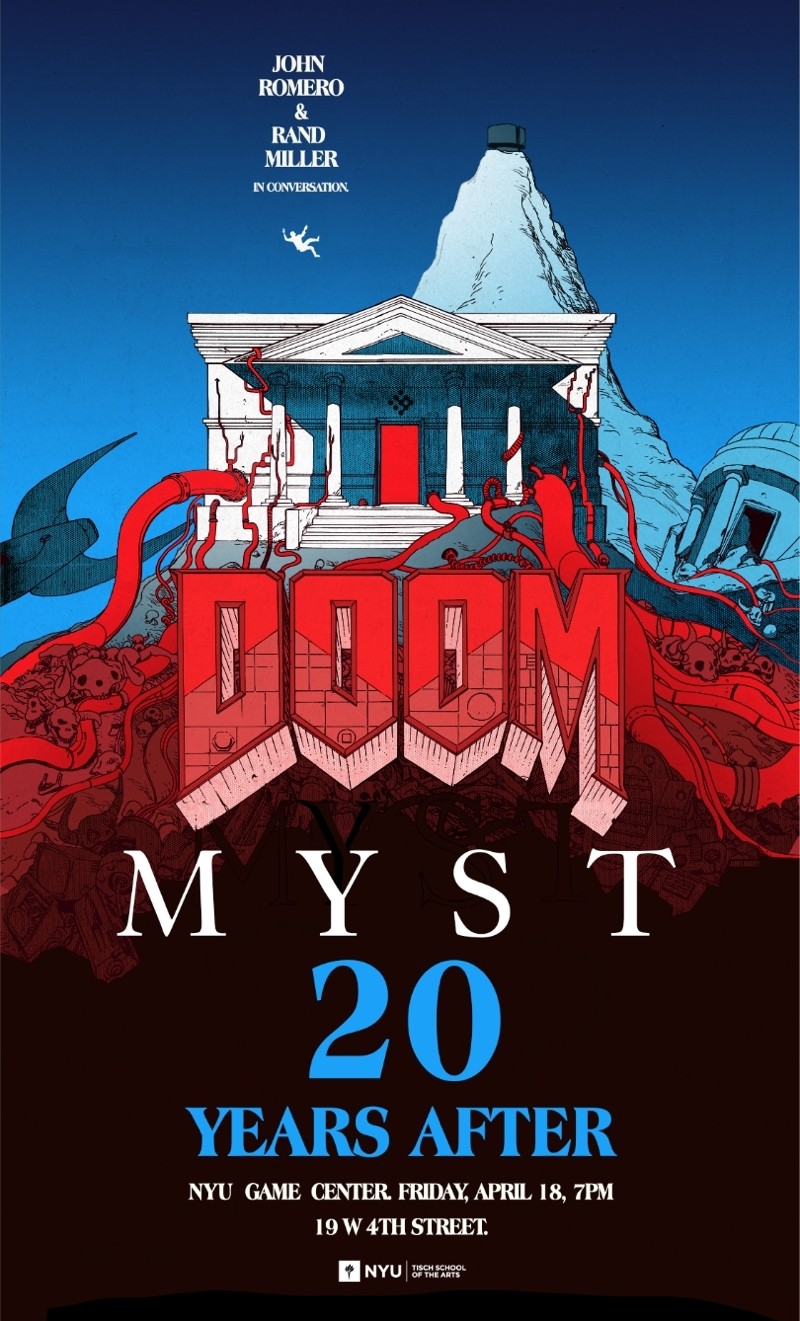
'"It's an adventure game! It's mass market! It's the anti-Doom! We have to crush this game!" -- "'What is this?! Demons on Mars?! People are playing this?!"
It's been more than 20 years since iconic games Doom and Myst changed the landscape of video games forever. One exponentially advanced the language and possibilities of the first-person shooter genre and the other pulled players into a fictional world like never before.
Despite the fact that they spoke to vastly different audiences, both games were huge, phenomenal hits. Not surprisingly, two of the men instrumental to each game's success initially hated the game the other guy produced.
This past Friday, legendary game-makers John Romero (Doom) and Rand Miller (Myst) sat down at the NYU Game Center to tell tales from the development of their important releases. When Game Center director Frank Lantz asked them what they thought of the other person's game when they first encountered them two decades ago, the difference in attitude and approach was clear.
Romero answered first, recalling how early internet groups like Usenet used to have lists of the most talked-about (and presumably best-selling) games. The day came when Wolfenstein 3D was shoved off the top of the charts by Myst. Romero's reaction to seeing the mega-successful game he worked on being taken out? "What?! Myst took down Wolfenstein?!" Romero said that he hadn't played Miller's transformative puzzle game. "We were so busy playing and making our games," he offered. But, when he looked into the enigmatic title that drew attention away from Id Software's Nazi killfest, he reacted in the brash fashion that defined his persona. He remembered howling, "It's an adventure game! It's mass market! It's the anti-DOOM! We have to crush this game!"

Miller's recollection of sitting down to play Doom wasn't as angry. But he too scratched his head a bit when he came to grips with the competition. Like Romero and his Id co-horts, Miller and the crew that made up Cyan Worlds were too busy working on Myst to play Doom right when it hit. But then came the need to "get away from what you're working on," he said. When he finally started the action on the Red Planet, he was incredulous. "What is this?! Demons on Mars?! People are playing this?!" Nevertheless, he was drawn in. "[Then, it eventually became] Ok, one more time...."
The two games' legacy can be traced into both the big-budget AAA games and the smaller indie titles on today's landscape. Miller and Romero spoke of the humble beginning for both titles, with Miller saying that in those pre-broadband days they paid somebody to transport the really big files on drives to other staffers who needed them.
Romero said that Doom was the 89th game that he'd made up until 1993. In November 1992, he and the other Id men worked in an office space called the Black Cube in Mesquite, Texas. Their ambitions were not small. "This has to be the best game in the world," Romero summed up the general attitude of he and his fellow Doom creators shared. "We put a press release out in January saying that [Doom was going to be the best game in the world] and then starting working on it," he said, in a remembrance that got a big laugh from the packed room. "The engine was up and running two months into development," he continued. About his one-time colleague John Carmack, Romero said he was "a brilliant, brilliant guy." "Anybody in the world would be lucky to work with someone as smart as him."

Miller relayed a similar story about the birth of Myst, where he, his brother Robin and other Cyan guys had to talk a big game before they actually made one. Miller's pre-Myst titles were children's software but, looking back on them, one could see that they were still building worlds. When a Japanese company (then known as Sunsoft) approached Miller and crew about making something for an older audience, that was the moment they decided to make a big jump. "We're building this for mass market," he remembered. "This is gonna be different."
Miller talked about how the Japanese company fronting the money for proto-Myst kept asking, "Are you going to sell more than The 7th Guest?" "Yep" was the confident reply but, in reality, Miller wasn't yet aware of Rob Landeros and Graeme Devine's seminal CD-ROM puzzle thriller. "What's The 7th Guest?," he remembered thinking.
Lantz noted how modern-day games have re-joined combat and puzzle-solving in one packages, a stark contrast to the days when the core elements of Doom and Myst seemed irreconcilable. Miller said that the brainteasers in Myst served a pragmatic purpose. "Puzzles were 'friction' to slow people down," he revealed. "My brother and I weren't even puzzle fans. But we built them into the environment to create a pace for people and let other technical things happen in the background. We thought of it as an exploration game and not a puzzle game. I look back now and it seems so haphazard. Two levers in a clock tower? That doesn't make any sense."
One of Doom's most important ideas, Romero said, was that none of the weapons in the game make the ones that come before obsolete. Another key feature was Doom's technological foundation. "[It was] a game engine that made it really easy to make 3D---well, 2.5D--- spaces. The engine [also] made it easy to make scary stuff because diminished lighting was built in." The Doom source code was made to easily modifiable because Romero and his co-workers wanted more games like Doom. "So we would tell anyone who wanted to know how we did what we did," he said. "That doesn't mean that they were going to make the same stuff."
Romero observed that one thing that's become common practice has been to make games on machines better than the ones meant to play them. You didn't make Nintendo games on a NES. You made it on a PC, he offered. Back in the day, the superior machines were Apples and Macs.
Romero: "We would tell anyone who wanted to know how we did what we did [on Doom]."
Piggybacking on that point, Miller said part of what helped Myst succeed was an awareness of what the home computers the game would be played on couldn't do. "Designing within tech limitations is the most important question for anybody making games," he declared. "A lot of projects fail because they don't think of the box [the limitations] ahead of time. [For example, with Myst] the 256 colors that they gave you by default were hideous so we had to adjust for that."
Romero's now helping head up a game design program at University of California, Santa Cruz, along with his wife Brenda, a legendary game-maker who worked on Wizardry, Jagged Alliance and Dungeons & Dragons. Miller's current project is the freshly crowdfunded Obduction, a spiritual sequel to Myst. Both men remarked on the importance and impact of indie/small-team game-making on the past and present of video games. "If you wanna be an indie, just make your own games at home. Make games during the day for someone else and make games at night for yourself," Romero said, adding that the games you make for yourself will ultimately be more meaningful.
Close to the end of their talk, Miller said that he feels like video games as an interactive form are still in their infancy. "We're still learning how to use it but that doesn't mean you trivialize it. We can put some stuff in here that makes people think about themselves and the world."
https://www.techspot.com/news/56503-what-creators-doom-myst-thought-each-others-games-1993.html
